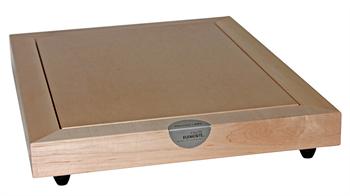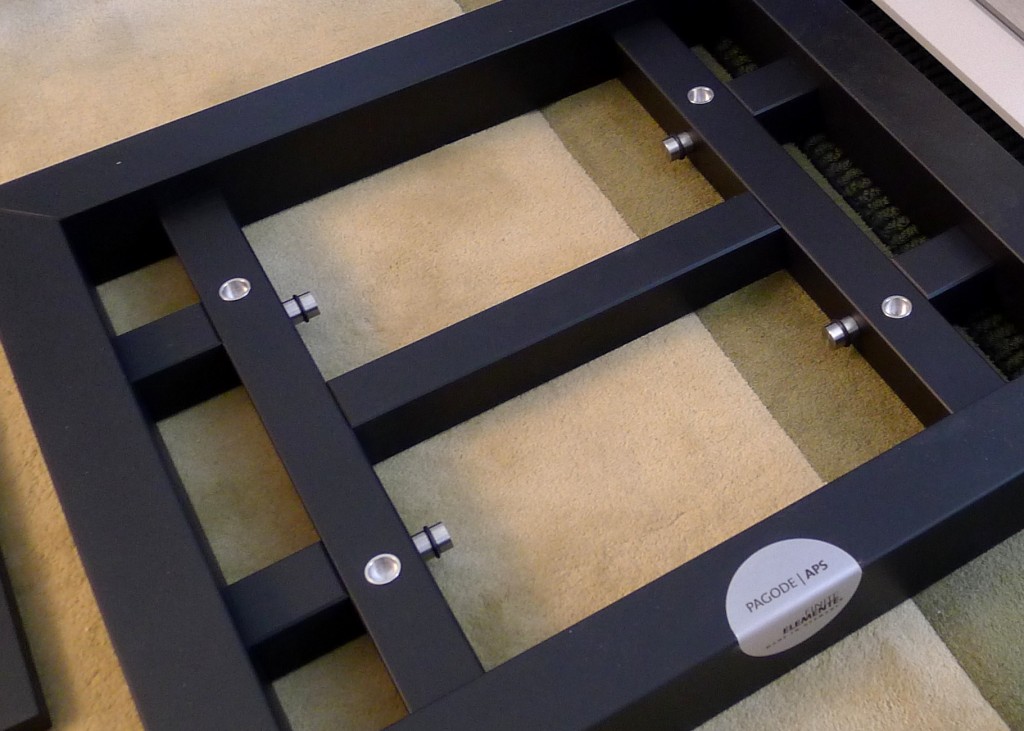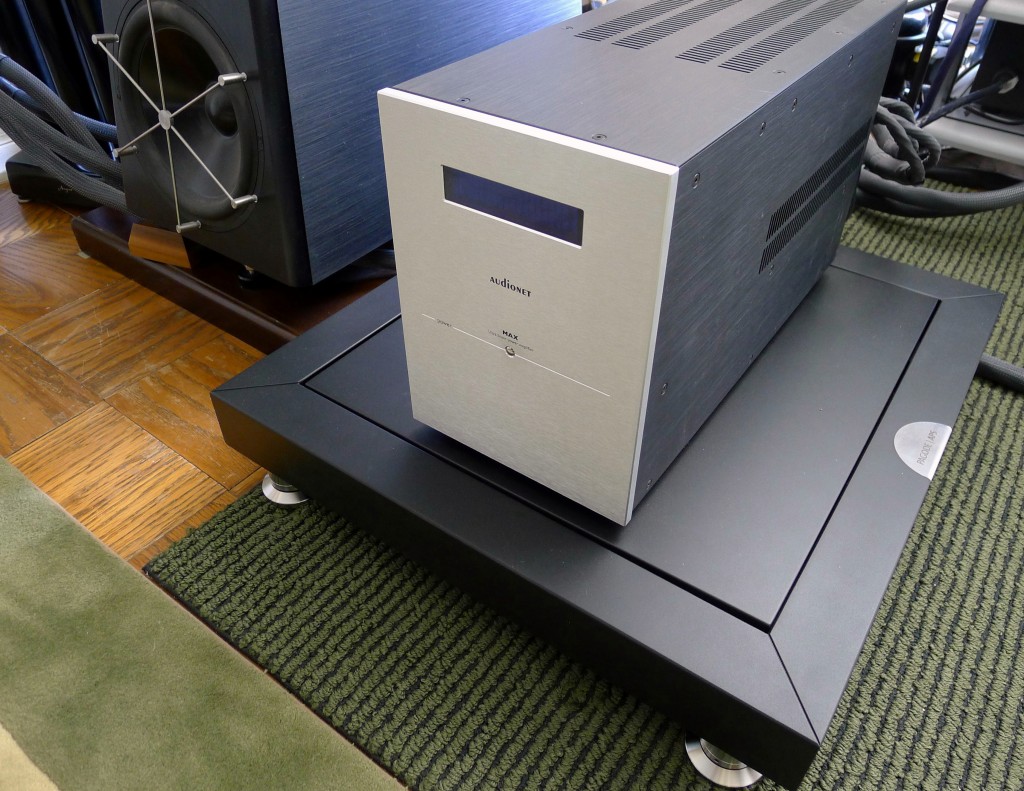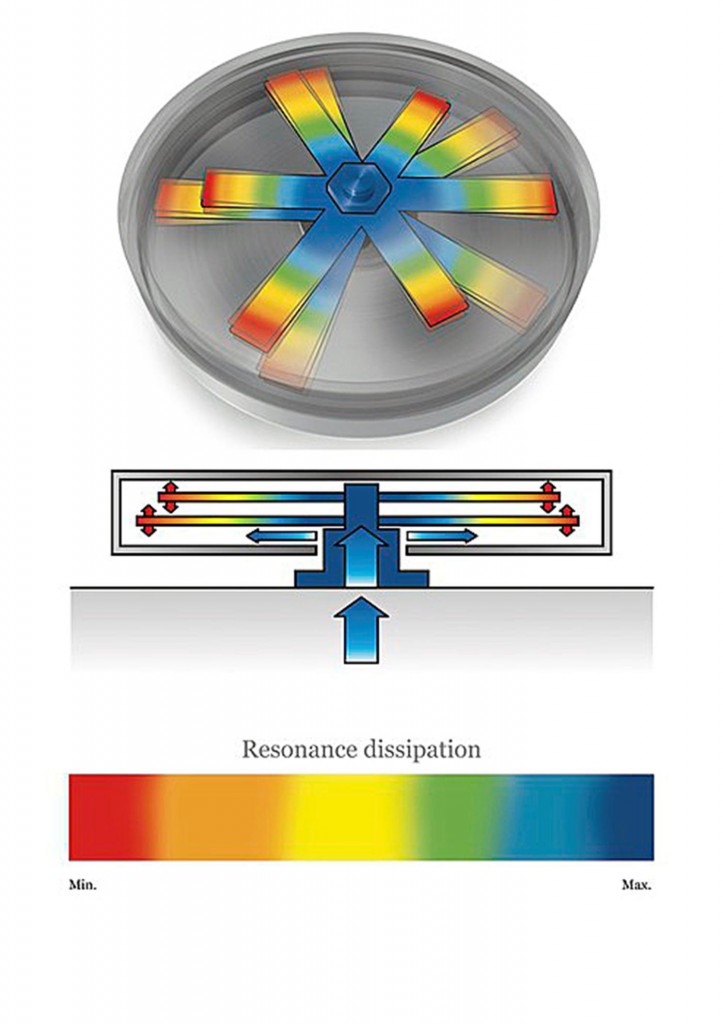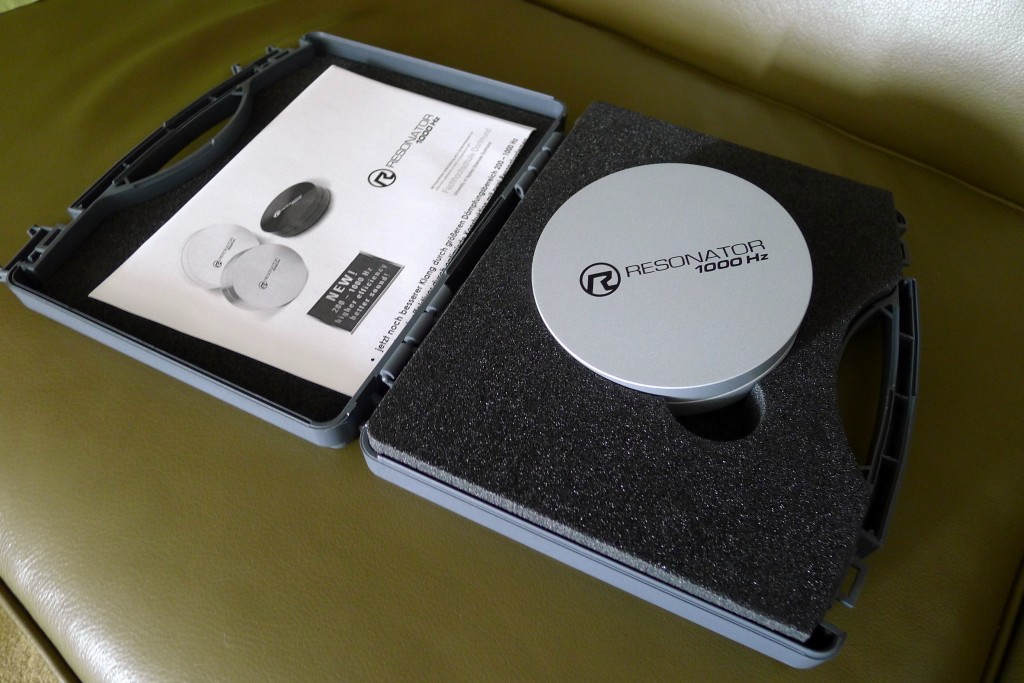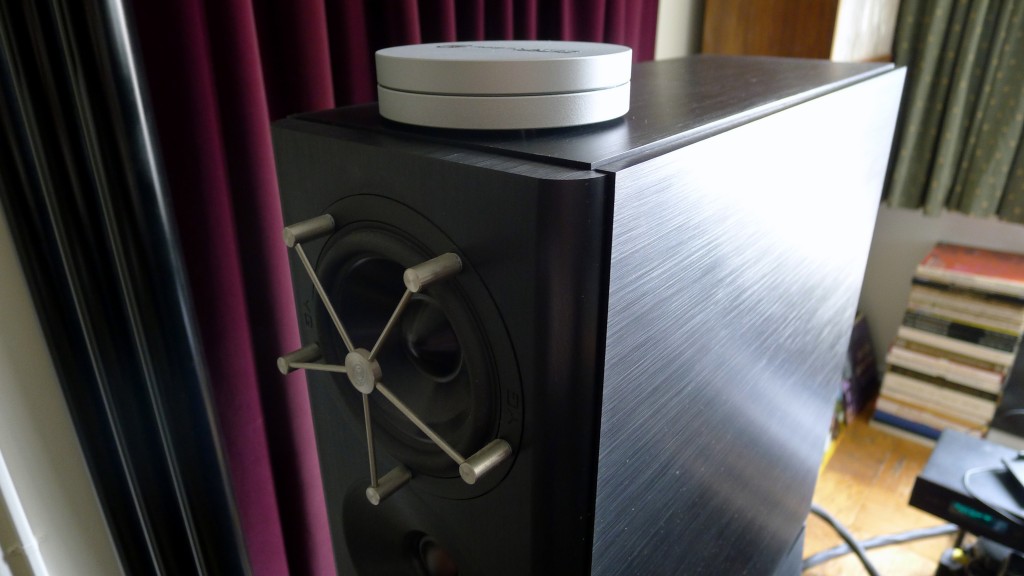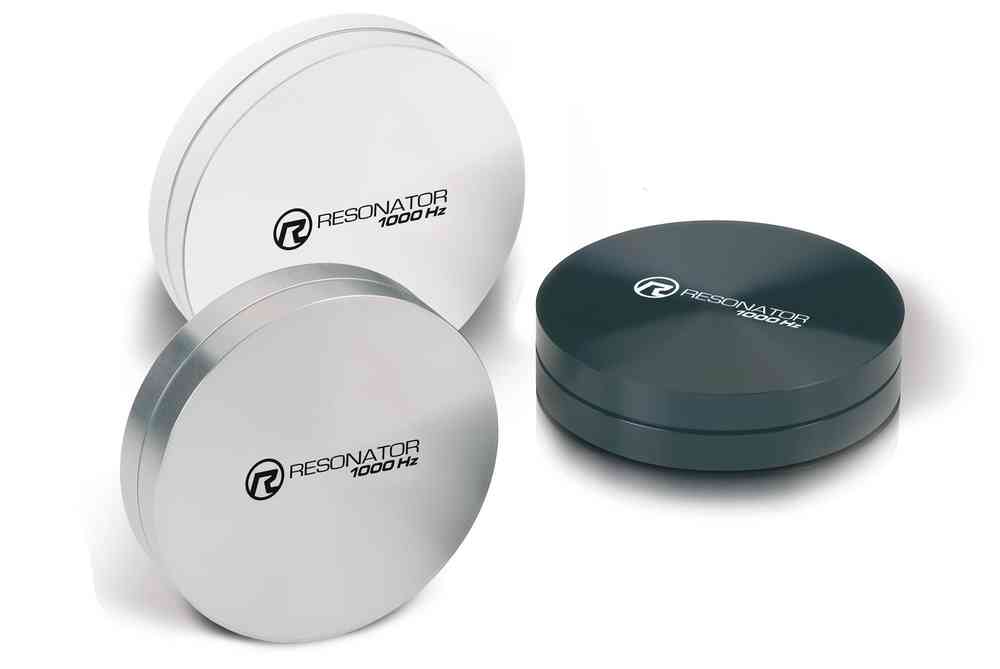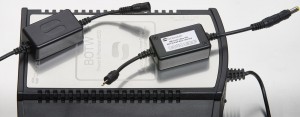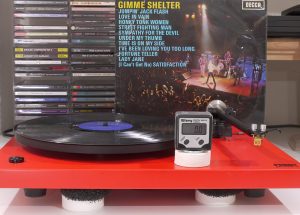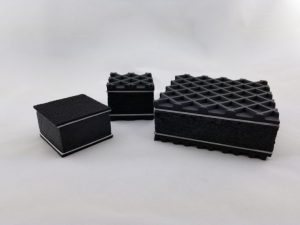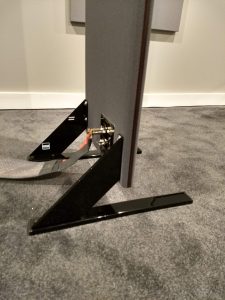I like the idea of resonators as a prescription: Take one a day to keep the shakes away. Ha! Not quite, just me being silly.
Seriously though, they are a sonic purgative. The actual prescription is to put them at strategic points on your components to prevent vibrations or mechanical energy from doing mischief. As you know, all materials exhibit non-linear response due to nodes or excitation points. Subject various types of audio racks or stands under stress to laboratory measurement and the graphical analysis is not a pretty thing to gaze upon.
APS Amp Stand Resonator Implementation
I first got acquainted with Finite Elemente's solution when I reviewed their APS Amp Stand. Basically, the goal was to design an amp stand that measures flat as a doormat when subjected to impinging energy. They eliminated as many nodes as they could, but not all nodes can be gotten rid of. Let's say one remained at 512Hz. To take care of that they made a resonator precisely tuned to 512Hz. Four resonators are attached to each platform.
When resonance or vibration energy impinges on the amp stand, the resonators, being faster responders, quickly shunt it off and convert it to heat before the platform has a chance to react. The sound-distorting energy at the excitation node is nulled. Subject the Finite Elemente component supports to stress and measure it in the laboratory, you will see a nearly picture perfect linear response.
This strikes me as brilliant, both in concept and implementation. Installed in my room, they were very effective, the principal effects noted were:
Everything relaxed; tone became sweet, almost silken... After the swap, the strings lost their aggressive treble edge and toned down, becoming midrangy, and gained mass. At first it was startling, but acclimation to the reduced treble happened fast….many of the problems disappeared. You were left with something that was easier to read.
Standalone Resonator Implementation
This time around, I'm evaluating the Resonator Reference Tuning Device. Like the APS Amp Stand, it incorporates a resonator, but one designed to react to a broadband of frequencies between 200-1000Hz. In effect, it lies in wait to gobble up any extraneous energy in that broad range.
Resonator diagram
The resonator inside looks different, too. It is a small, flexible, star-shaped steel ribbon housed in an anodized aluminum and stainless steel disc, 4.7" diameter by 1.2" tall, weighing .82 lbs. The device is neither large nor heavy. Its mode of operation, implementation, and effects are different from the amp stand resonators.
The box contained a one-page sheet with minimal instructions; the distributors' website offered little more. Basically, you place them on top of any component that seems promising. Then shuffle them around side to side, front to back, to ascertain the point of optimum impact.
The position of the resonator is determined empirically within the recommended area to achieve maximum reduction in resonance. The critical resonance range between 200Hz and 1000Hz becomes effectively damped.
My first attempt on the CH Precision D1 SACD Player yielded nada. Try somewhere else… again nothing. Through trial and error I found the spots. Improbably, maximum impact was on top of my YG Anat speakers' main module, close by the baffle edge and near the driver cones. This was wholly surprising since the YG speakers undergo rigorous laboratory analysis and tests to insure a flat response and are entirely constructed of double-walled aluminum. Steps are taken to remove resonances. It's well-known that YG goes the last mile in their over-the-top design methodology and construction processes. You would think they are as inert as is possible. But the Resonators found excitation nodes—or something—to calm down. I bet Mr. Yoav Geva will be keenly interested to learn about this.
I got nearly as good results when I put the Resonators on the Audionet MAX Monoblocks. In other placement, like on any of the CH Precision gear, there was no discernable impact. You have to experiment to see what works.
Let's begin with Groovewise, with pianist Eric Reed (Smoke Sessions SSR-1410). After the major record labels bowed out of the CD market, the music industry evolved and the ensuing vacuum allowed for the emergence of micro labels. Smoke Sessions is one example of a jazz club with an in-house imprimatur. So far it has produced CDs with superior sound and performances—chalk that up to the owner being an audiophile and having great taste. BTW: the same model has been adopted in the classical arena, where many first-rank orchestras now produce their own CDs. All in all, things have worked out quite well.
The APS Amp Stands are under my Audionet MAX amps and Groovewise is sounding great. With the addition of a Resonator on top of each YG Anat main module, I can't say anything dramatic happens. This is unlike when I installed the APS Amp Stands—that was radical and took getting used to. This time, the frequency balance didn't shift and there is no change in the treble. The gestalt of the presentation is pretty much what it had been.
However, closer listening reveals a different soundstage. The aural lens tightened its grip: ill-defined borders firm up and edge details come into view; images become taut and a little leaner. This is unlike the amp stands, where images gained mass and size inflated.
I began with a wall of sound across the span of the speakers when the music got dense. With the Resonators in place, I had the same wall, except it was composed of individual instruments, never a blend. The dimensions of the stage were unchanged, but the presentation upon it was tighter, more controlled. This was the Resonators at work on the mids through lower treble, stripping out softness and fat.
Its Got Presence
The latest ears to join my panel, David, pointed out newfound bloom in the midrange. And his wife, Teresa, was simply bowled over by the tactile quality. "The [Resonators] make you sit up and pay attention. They will not create background music." Her focus and concentration was a thing to behold.
These details coalesce and develop into a remarkable presence. The "in the room" immediacy is often sensational with superior recordings. Definitely not a balcony seat, beyond even a mid-orchestra one, the Resonators place you alongside the center microphone above the conductor; you hear what that mic picked up. It's not so much a "you are there" at the recording venue; it's more like a "they are here" in your room.
Then, on a lark, Lynn suggested moving the pair of Resonators to tabletops midway on either side of the room. Wow! I know this is getting pretty far out, but now the sound moved forward several feet in front of the speakers. This suggests the Resonator also works on airborne energy, not just what's transmitted from the component it's sitting on.
Maximizing the Impact
It shouldn't be a surprise that the better the recording, the more potent the Resonator's effects. Curiously, that held true for the room itself, too. Yes, I had occasion to work on my room in the course of the Resonator audition, beefing up the first reflection point on the side wall with an additional absorption panel.
Holy cow! Now with the Resonators midway into the room and the beefed-up side wall treatment, I stayed up late into the night listening to SACD after SACD. The illusion of 3-D space was very powerful. While the stage itself had great depth layering to start, this new thing was a property of individual instruments. It was as if each instrument had been granted that third dimension and expanded front to back.
There was another side benefit: the illusion of 3-D made my awareness of my room's less than ideal physical width less noticeable. My room is only 12' wide; consequently, the width of the soundstage is challenged. But it seemed to matter less; my awareness of it receded, displaced by this new projection in the depth domain.
It became immersive and very attractive, but I wondered if it was too much? I don't experience this immersion in the real world.
Caveat Emptor
There is a single caveat. For Teresa, who is a professional conductor, music must have tactile quality and immediacy. For her, the Resonators were make or break: they brought engagement; without them the performance lost interest and became something in the background. But some visitors did not want that much engagement. They preferred something less demanding of their attention and easier to listen to.
Conclusion
There's an entire industry of audio tweaks that promise gains in resolution and focus. Many of the Finite Elemente Resonator effects can be obtained with other products. I've tried a lot. The Resonator is among the most effective.
Secondly, the theory underlying it is not voodoo. It eliminates artifacts; it doesn't alter the signal. It is fundamentally honest and everything it does helps to reveal the source. And what it offers in the realm of immediacy and presence is not redundant of any other product.
I find again and again that within the audiophile community there are subsets, small communities who seek quite different, even opposing, goals. The target audience for the Finite Elemente Resonators is those audiophiles seeking maximum "you are there" immediacy.
However, we're not all after the same thing. For those who prefer to listen to something less visceral, more laid back, the Resonators may not be suitable.
That's OK. Everyone is free to choose. Me? I'm with the immediacy crowd.
Resonator Reference Tuning Device
$540 ea.
Finite Elemente
www.finite-elemente.de/finite-elemente
Distributor information
Aaudio Imports
Parker, CO 80134
720-851-2525





